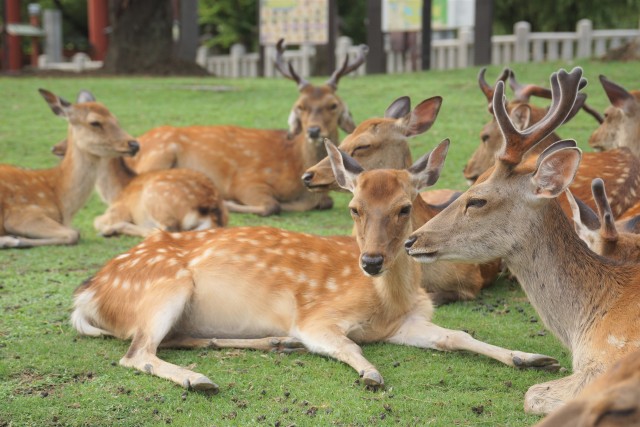
The animals behave differently this summer.
Every summer a bizarre phenomenon called “shikadamari” takes place in Nara Park, and our local reporter K. Masami has been documenting the event for the past few years.
Shikadamari literally translates to “deer pool” and it’s used to describe the gathering of deer that occurs in the summer months, when the animals relax on a particular patch of grass at the same hour, and for the same amount of time each day.
The unusual behaviour has been baffling local residents for years, with even the Nara Deer Preservation Foundation, who looks after the animals, unable to explain why the deer do what they do. So Masami has been on a mission of her own, recording the slight changes in start and end times from year to year, and noting the weather conditions at the same time in an effort to link the two.
As has been the case in previous years, this year’s shikadamari started earlier than the year before. While the deer used to gather on the grass in front of the Nara National Museum in July and August, in recent years the animals have been appearing from the end of May, or at the latest in mid-June.
This year, there were many days when the temperature exceeded 30 degrees Celsius (86 degrees Fahrenheit) in June, and when Masami spotted them at their spot during that time, she felt that rising temperatures and a desire to stay cool might definitely be a factor in why the deer gather here. Masami was curious to find out the end-date for the gathering, though, so she popped by on a mid-July evening when the maximum daily temperature reached over 30 degrees Celsius, and found that the deer were still meeting there, with a group of fascinated onlookers taking photos of them.
At 6:30 p.m., the deer took their place on the lawn and relaxed. At a rough count, there were about 60 animals at the gathering.
This was less than half the number of an average year, and Masami was surprised to see so few deer here, especially after the enormous numbers she witnessed back in 2019 and 2020.
▼ In 2019 there was barely a spare patch of green to be seen.
▼ The same spot in 2020.
▼ This year, a very different sight.
In case the low numbers might have been due to a July anomaly, Masami returned at the beginning of August to see if the animals might appear in greater numbers. However, when she returned on 12 and 13 August, when the deer gathering is usually in full swing, she found…there were no deer there at all.
Masami patiently waited at the spot until 7:30 p.m., and a few animals finally gathered, but there were only 26 of them. This was more like a puddle than a pool of deer, so she would hardly call it a shikadamari.
Masami wasn’t the only one surprised by the absence of the animals, with others around her murmuring, “How strange!” to each other. It wasn’t like there no deer in that area of the park, as there were plenty of them nearby, but they were all nibbling on grass rather than relaxing on the lawn as they usually do.
Has there ever been a year like this? Masami doesn’t think so. This is the earliest end-date for the gathering she’s seen in recent years, when rain on the day wasn’t an influencing factor, and she wasn’t sure what could’ve caused it. It might’ve been due to recent rain, or the heat of the season peaking earlier than usual, but one major difference Masami noticed this year was an increase in the number of visitors in the park.
In the previous three years, visitor numbers dropped dramatically due to the pandemic, and during that time the number of deer gathering at the spot became greater than ever before. Now, with more people travelling this summer, Masami thinks the deer gathering might be related to visitor numbers — with more tourists to feed them their carb-rich senbei, the animals might have more energy at the end of the day to graze rather than conserve energy by staying still on the lawn.
It’s not an exact science but it’s something Masami thinks is notable, having observed the animals in the park frequently over the past three years. With the Nara Deer Preservation Foundation no closer to understanding the ebbs and flows of shikadamari, nor why it occurs, Masami’s yearly observations are the best thing we have right now for looking at possible explanations for the animals’ behaviour. If you or anyone you know has any more information, please let us know!
Photos © SoraNews24
● Want to hear about SoraNews24’s latest articles as soon as they’re published? Follow us on Facebook and Twitter!